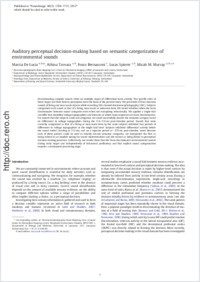Auditory perceptual decision-making based on semantic categorization of environmental sounds
- Lucia, Marzia De Electroencephalography Brain Mapping Core, Center for Biomedical Imaging (CIBM) of Lausanne and Geneva, Switzerland - Department of Radiology, Centre Hospitalier Universitaire Vaudois (CHUV), Lausanne, Switzerland
- Tzovara, Athina Electroencephalography Brain Mapping Core, Center for Biomedical Imaging (CIBM) of Lausanne and Geneva, Switzerland - Department of Radiology, Centre Hospitalier Universitaire Vaudois (CHUV), Lausanne, Switzerland
- Bernasconi, Fosco Neuropsychology and Neurorehabilitation Service, Department of Clinical Neurosciences, CHUV, Lausanne, Switzerland
- Spierer, Lucas Neuropsychology and Neurorehabilitation Service, Department of Clinical Neurosciences, CHUV, Lausanne, Switzerland - Neurology Unit, Department of Medicine, Faculty of Science, University of Fribourg, Switzerland
- Murray, Micah M. Electroencephalography Brain Mapping Core, Center for Biomedical Imaging (CIBM) of Lausanne and Geneva, Switzerland - Department of Radiology, Centre Hospitalier Universitaire Vaudois (CHUV), Lausanne, Switzerland - Neuropsychology and Neurorehabilitation Service, Department of Clinical Neurosciences, CHUV, Lausanne, Switzerland
-
08.02.2012
Published in:
- NeuroImage. - 2012, vol. 60, no. 3, p. 1704–1715
English
Discriminating complex sounds relies on multiple stages of differential brain activity. The specific roles of these stages and their links to perception were the focus of the present study. We presented 250 ms duration sounds of living and man-made objects while recording 160-channel electroencephalography (EEG). Subjects categorized each sound as that of a living, man-made or unknown item. We tested whether/when the brain discriminates between sound categories even when not transpiring behaviorally. We applied a single-trial classifier that identified voltage topographies and latencies at which brain responses are most discriminative. For sounds that the subjects could not categorize, we could successfully decode the semantic category based on differences in voltage topographies during the 116–174 ms post-stimulus period. Sounds that were correctly categorized as that of a living or man-made item by the same subjects exhibited two periods of differences in voltage topographies at the single-trial level. Subjects exhibited differential activity before the sound ended (starting at 112 ms) and on a separate period at ~ 270 ms post-stimulus onset. Because each of these periods could be used to reliably decode semantic categories, we interpreted the first as being related to an implicit tuning for sound representations and the second as being linked to perceptual decision-making processes. Collectively, our results show that the brain discriminates environmental sounds during early stages and independently of behavioral proficiency and that explicit sound categorization requires a subsequent processing stage.
- Faculty
- Faculté des sciences et de médecine
- Department
- Médecine 3ème année
- Language
-
- English
- Classification
- Biological sciences
- License
- License undefined
- Identifiers
-
- RERO DOC 29591
- DOI 10.1016/j.neuroimage.2012.01.131
- Persistent URL
- https://folia.unifr.ch/unifr/documents/302484
Other files
Statistics
Document views: 73
File downloads:
- spi_apd.pdf: 159
- spi_apd_sm.pdf: 111

